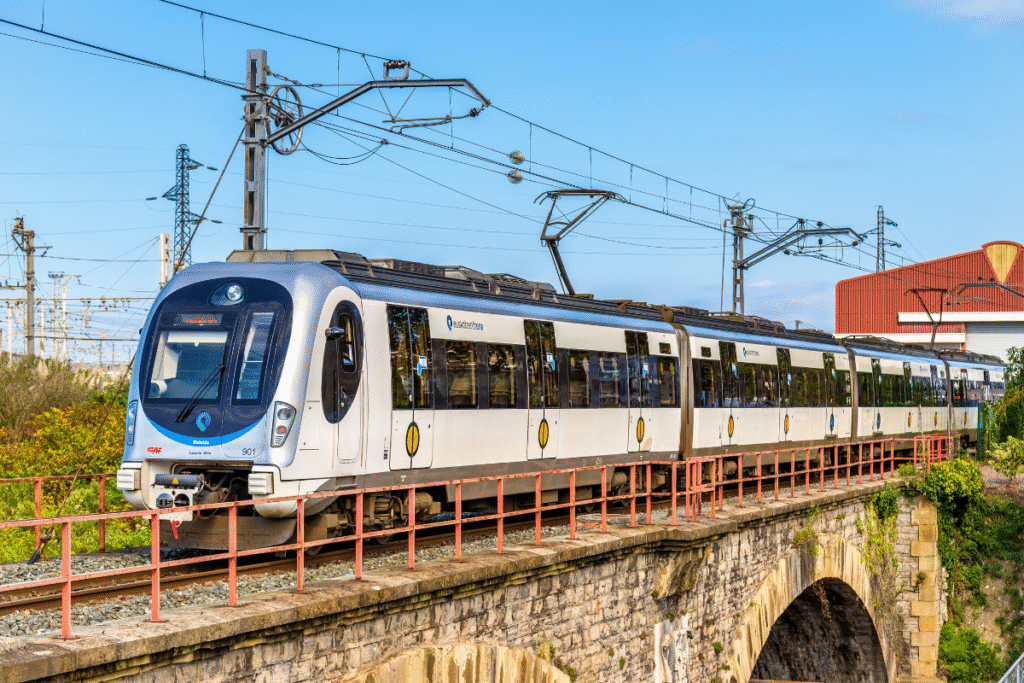
High-speed train on a viaduct — scenes disrupted after Lille cable thefts. Credit: Leonid Andronov via Canva.com
It was supposed to be just another travel day. However, on June 24 and 25, 2025, trains between the UK and mainland Europe abruptly ceased operation. Eurostar passengers found themselves stranded mid-route, and not just because of delays. In northern France, two separate incidents near Lille paralysed the high-speed network. One involved a fatal collision on the LGV Nord tracks. Less than a day later, a 600-metre stretch of signalling cable near Lille-Europe failed, knocking out service in both directions. Travellers sat for hours in terminals across London, Paris, and Brussels, unsure if they’d get moving again that day. Some trains were cancelled outright, others slowed to a crawl, while call centres buckled under the pressure of frustrated passengers.
By evening, most routes had reopened — but the disruption exposed more than just a technical fault. It showed just how quickly Europe’s tightly linked rail system can fall apart.
So what exactly happened near Lille? Who was impacted? And what does this disruption reveal about the systems meant to keep European travel moving?
A fatal start
On June 24th, two separate individuals were struck by high-speed trains on the LGV Nord line in Lille, in northern France.
- Multiple users in the TGV services were cancelled or suspended as the police and emergency services responded to the scene.
- In the early hours of June 25th, less than 12 hours after services resumed, engineers discovered that around 600 metres of a significant section of signalling cable had been stolen near Lille Europe station.
- That damage disabled the central signalling systems, which crippled the rail line once again. This time, it halted several SNCF TGV services as well.
The rail crews worked throughout the morning to manually rewire the damaged section, and according to French officials, six services were cancelled, with others running with delays exceeding 2 hours.
These two incidents stranded passengers across France, the UK, and Belgium in stations, stuck on trains with limited air conditioning, or scrambling for compensation, all of which spread confusion across the terminals.
Delays, silence, and missed lives
The stolen cable that occurred near Lille was part of a broader trend that is disrupting rail travel across Europe. Over the last two years, rail operators in France, Spain, the UK, and the Netherlands have all reported a spike in metal theft targeting signalling cables made of copper. As copper prices globally climb, resale on the black market has surged. So, this is a lucrative, if dangerous target.
Railway signalling systems rely on copper to relay live data to switches, crossings, and control centres. When even one section is removed, the entire corridors go blind. Trains must slow down or stop altogether, and it can take hours, sometimes days, to verify the line is safe again.
The Lille incident also exposed a critical weakness: accessibility. The cable was stolen just outside one of France’s most heavily trafficked rail hubs. Despite this, the area was left vulnerable — no active surveillance, no deterrents, no alarms.
Elsewhere in Europe, there’s growing concern that rail infrastructure may be underprepared for intentional disruption.
- In April, Dutch authorities investigated a tampering attempt near Rotterdam, targeting a freight line linked to the Port.
- German police increased patrols along ICE routes earlier this year after activists claimed responsibility for cable cutting in protest of defence shipments.
- Spain’s 2024 report on rail vulnerability explicitly listed “signal cable sabotage” as a top-tier infrastructure threat.
For now, Eurostar and SNCF have confirmed they’re reviewing security protocols around Lille-Europe and other “critical points” along the LGV Nord. But without more proactive investment in surveillance tech and theft-resistant systems, experts warn these attacks will only continue, especially as summer travel peaks.







